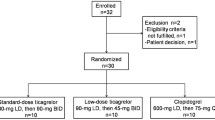Abstract
BackgroundInadequate platelet inhibition despite aspirin and clopidogrel therapy during and after a percutaneous coronary intervention is associated with an impaired clinical outcome. Cangrelor, a direct and reversible P2Y12 inhibitor that is currently in development, has the potential to achieve higher levels of inhibition of ADP-induced platelet aggregation than clopidogrel. The aim of the present study was to compare the magnitude of platelet inhibition in clopidogrel-pretreated patients before and after the in vitro addition of a subtherapeutic dose of cangrelor.
MethodsBlood samples were drawn from patients pretreated with clopidogrel and aspirin who were undergoing elective percutaneous coronary intervention (n=39). Platelet function analysis with ‘classical’ light transmittance aggregometry (both peak and late aggregation [at 6 min]) was performed before and after the in vitro addition of cangrelor (0.25 μmol/l) to platelet-rich plasma (PRP). After an incubation period of five minutes, platelet aggregation was induced by 5 and 20 μmol/l ADP.
ResultsThe in vitro addition of 0.25μmol/l cangrelor to the PRP from clopidogrel-treated subjects resulted in an additional reduction in ADP-induced platelet aggregation. For ADP concentrations of 5 and 20 μmol/l, peak aggregation showed a decrease of 75 and 85%, respectively (p<0.001 for both), while late aggregation was almost completely diminished (p=0.003 and p<0.001, respectively). Furthermore, the interindividual variation in inhibition of ADP-induced platelet aggregation by clopidogrel was greatly reduced after the addition of cangrelor.
ConclusionWe demonstrate that the in vitro addition of even a subtherapeutic dose of cangrelor to the PRP of clopidogrel-pretreated patients results in an additional reduction of ADP-induced platelet aggregation. Moreover, cangrelor was able to diminish the interindividual variation observed in clopidogrel-inhibited platelet aggregation. (Neth Heart J 2009;17:195–8.)
Similar content being viewed by others
References
Savi P, Pereillo JM, Uzabiaga MF, Combalbert J, Picard C, Maffrand JP, et al. Identification and biological activity of the active metabolite of clopidogrel. Thromb Haemost 2000;84:891–6.
Jaremo P, Lindahl TL, Fransson SG, Richter A. Individual variations of platelet inhibition after loading doses of clopidogrel. J Intern Med 2002;252:233–8.
Serebruany VL, Steinhubl SR, Berger PB, Malinin AI, Bhatt DL, Topol EJ. Variability in platelet responsiveness to clopidogrel among 544 individuals. J Am Coll Cardiol 2005;45:246–51.
Geisler T, Langer H, Wydymus M, Gohring K, Zurn C, Bigalke B, et al. Low response to clopidogrel is associated with cardiovascular outcome after coronary stent implantation. Eur Heart J 2006; 27:2420–5.
Cuisset T, Frere C, Quilici J, Morange PE, Nait-Saidi L, Carvajal J, et al. Benefit of a 600-mg loading dose of clopidogrel on platelet reactivity and clinical outcomes in patients with non-ST-segment elevation acute coronary syndrome undergoing coronary stenting. J Am Coll Cardiol 2006;48:1339–45.
Buonamici P, Marcucci R, Migliorini A, Gensini GF, Santini A, Paniccia R, et al. Impact of platelet reactivity after clopidogrel administration on drug-eluting stent thrombosis. J Am Coll Cardiol 2007;49:2312–7.
Wiviott SD, Braunwald E, McCabe CH, Montalescot G, Ruzyllo W, Gottlieb S, et al. Prasugrel versus clopidogrel in patients with acute coronary syndromes. N Engl J Med 2007;357:2001–15.
Fugate SE, Cudd LA. Cangrelor for treatment of coronary thrombosis. Ann Pharmacother 2006;40:925–30.
Storey RF, Newby LJ, Heptinstall S. Effects of P2Y(1) and P2Y(12) receptor antagonists on platelet aggregation induced by different agonists in human whole blood. Platelets 2001;12:443–7.
Storey RF, Oldroyd KG, Wilcox RG. Open multicentre study of the P2T receptor antagonist AR-C69931MX assessing safety, tolerability and activity in patients with acute coronary syndromes. Thromb Haemost 2001;85:401–7.
van Werkum JW, Hackeng CM, de Korte FI, Verheugt FW, Ten Berg JM. Point-of-care platelet function testing in patients undergoing PCI: between a rock and a hard place. Neth Heart J 2007;15:299–305.
van Werkum JW, Kleibeuker M, Mieremet N, Ten Berg JM, Hackeng CM. Evaluation of the platelet response to clopidogrel with light transmittance aggregometry: peak aggregation or late aggregation? J Thromb Haemost 2007;5:884–6.
Author information
Authors and Affiliations
Additional information
Department of Cardiology, St. Antonius Hospital, Nieuwegein, the Netherlands
Department of Clinical Chemistry, St. Antonius Hospital, Nieuwegein, the Netherlands
Department of Cardiology, UMC St Radboud Nijmegen, the Netherlands
Department of Cardiology, St. Antonius Hospital, PO Box 2500, 3435 CM Nieuwegein, the Netherlands
Rights and permissions
About this article
Cite this article
Bouman, H.J., van Werkum, J.W., Hackeng, C.M. et al. Cangrelor increases the magnitude of platelet inhibition and reduces interindividual variability in clopidogrel-pretreated subjects. NHJL 17, 195–198 (2009). https://doi.org/10.1007/BF03086246
Issue Date:
DOI: https://doi.org/10.1007/BF03086246




